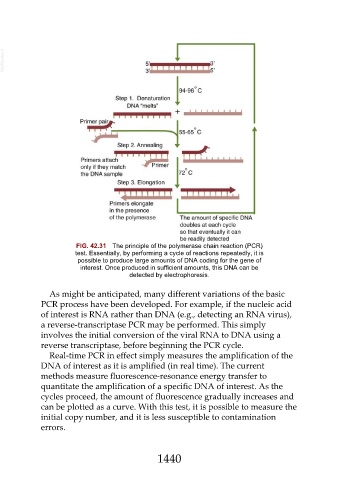Page 1440 - Veterinary Immunology, 10th Edition
P. 1440
VetBooks.ir
FIG. 42.31 The principle of the polymerase chain reaction (PCR)
test. Essentially, by performing a cycle of reactions repeatedly, it is
possible to produce large amounts of DNA coding for the gene of
interest. Once produced in sufficient amounts, this DNA can be
detected by electrophoresis.
As might be anticipated, many different variations of the basic
PCR process have been developed. For example, if the nucleic acid
of interest is RNA rather than DNA (e.g., detecting an RNA virus),
a reverse-transcriptase PCR may be performed. This simply
involves the initial conversion of the viral RNA to DNA using a
reverse transcriptase, before beginning the PCR cycle.
Real-time PCR in effect simply measures the amplification of the
DNA of interest as it is amplified (in real time). The current
methods measure fluorescence-resonance energy transfer to
quantitate the amplification of a specific DNA of interest. As the
cycles proceed, the amount of fluorescence gradually increases and
can be plotted as a curve. With this test, it is possible to measure the
initial copy number, and it is less susceptible to contamination
errors.
1440

